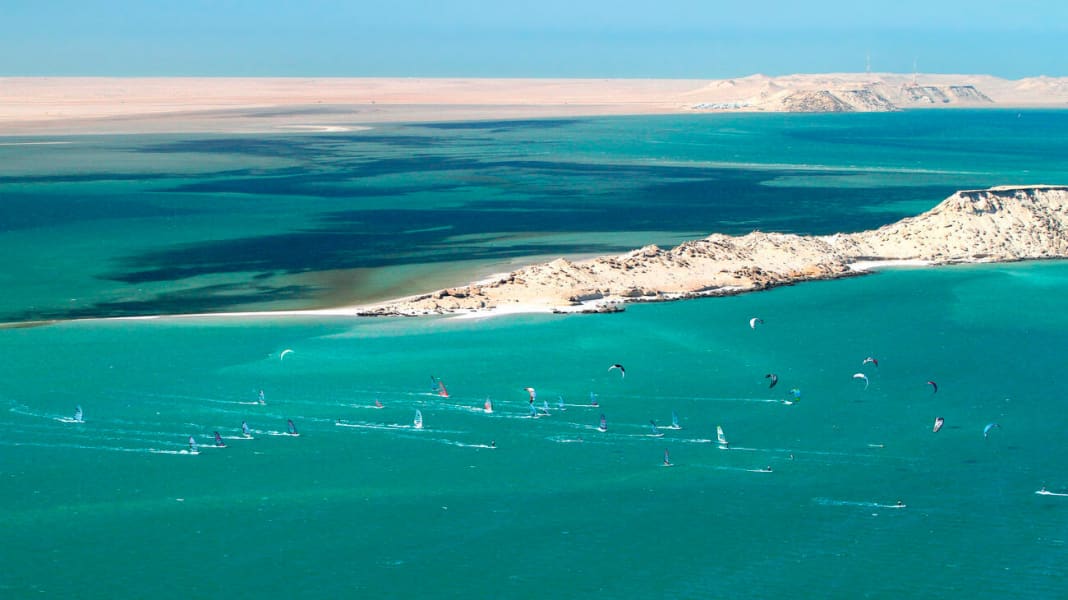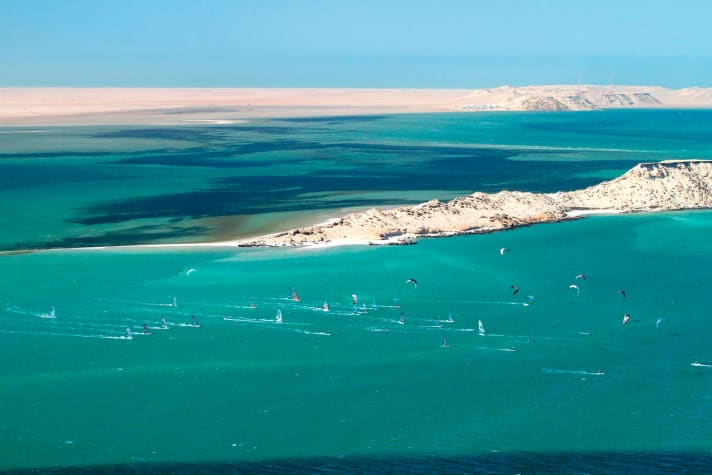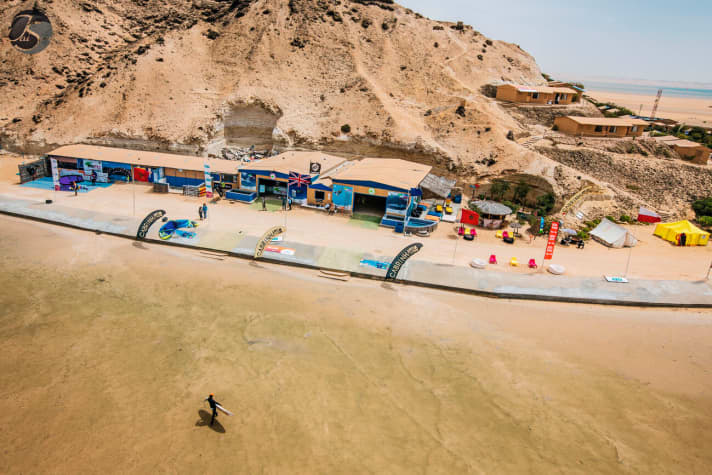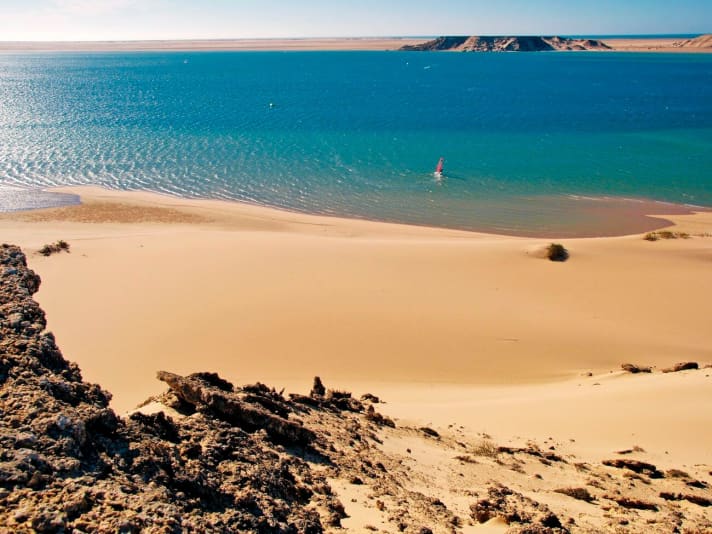

In summer, it blows out of all the pipes here and the spot is top for all pure strong wind fans - now in winter it's a little more moderate. The wind still blows with planing force on two thirds of all days, but the endless, shallow lagoon and the surf centre on site make Dakhla one of the few warm spots that can be reached quickly and comparatively cheaply in winter and is also suitable for practising water starts, planing or jibing manoeuvres.The best time to travel for newcomers are the winter months, between November and April.
In line with the selection of the top spots in surf issue 1/2 2017, we present you here once again in more detail theTop spot number two for intermediates: The seemingly endless, shallow lagoon near Dakhla in Morocco.You should expect a flight time of at least seven hours in any case - depending on the flight connection and departure airport, it can be longer. The Moroccan desert with its remoteness and thermal wind will then welcome you warmly! With air temperatures of around 20 degrees (in summer it's a good 5 degrees more) and a pleasant 20 degrees in the water, a long wetsuit should always be in your luggage.
Wind:The wind blows here with gliding force a good 300 days a year, usually around the clock! As the trade wind zone, which provides the Canary Islands with constant wind in summer and the Cape Verde Islands in winter, is constantly shifting - with Dakhla halfway along the route - you benefit from the trade wind here virtually all year round. Due to the mountains in the hinterland, the wind is additionally funnelled and accelerated. From May to October, the wind here usually blows at six Beaufort, in winter it is usually one to two wind forces less - making it perfect for climbers. If you like graphics, you can do this in the Wind statistics of the Surf & Action Company (here for Dakhla-North) or also in the Wind statistics at Windfinder (measured at the airport, in the southern part of the lagoon).

Spots, surf stations and some of the accommodation: The lagoon is usually divided into the northern and southern areas. There are slightly fewer tourists in the south than at the northern end of the lagoon, although most of the tourists are water sports enthusiasts of all kinds anyway and you don't have to worry about excessive mass tourism here.
Dakhla-North is of course at the northern end of the lagoon. There are two camps with surf stations here:
Once the "Centre Rihfly Dakhla" which is connected to the "Dakhla Attitude" camp and the station from the "ION Club" formerly known as "Club Mistral". The latter is located in the very north, virtually in the deepest part of the lagoon, which means that there is hardly any wind wave here - but at low tide the surfing area becomes very small as it is simply too shallow in many places. You can then book a shuttle service to the speed spot at the "Centre Rihfly Dakhla" a little further south (subject to a charge).
The Speedspot which is created at low tide by a sandbank that is at least 600 metres long and lies at right angles to the usual wind direction, making it a world-class speed and freestyle spot, lies a good two kilometres downwind of the "Center Rihfly Dakhla". To get back to the centre, you would have to cross back to the station after the session.
For beginners and intermediates as well as all freeriders, there are also directly in front of the station plenty of space to let off steam. At high tide, there is a standing area measuring a good 300 metres by three kilometres directly in front of the station; at low tide, you may have to carry your equipment up to 350 metres to the water's edge. In the deeper area behind it, gentle choppy waves build up - here there is endless space to heat back and forth, so that all freeriders get their money's worth.
All centres also offer day trips and shuttle services to the surrounding wave and shallow water spots (for a fee). The centres in the north have a different programme of spots than the centre in the south.

Dakhla-South is, as the name suggests, located in the southern part of the lagoon. The transfer here from the airport takes a little longer, as you have to drive around the bay once. Right next to the "Heliophora Ecolodge" is the fairly new Surf and kite centre, the "Heliophora Riders Camp" - just 100 metres from the water's edge. Directly in front of the station at low tide is a Shallow water spot with huge standing area of up to 400 metres by two kilometres in size! At high tide, the water becomes a little choppier. The wind here usually blows sidshore from the right. For the adventurous and anyone who needs a change, the centre also offers paid trips to two flat water and two wave spots in the area. Otherwise, you can hire SUPs at the centre, book yoga lessons or simply relax under the Moroccan sun.
Beginners, intermediates, freestylers and speed junkies, freeriders and wave fans alike will find their surfing happiness here.
Even more detailed information is available, for example, on the website of the Surf & Action Company, both for Dakhla-North ( here ) as well as for Dakhla South ( here ). There you will also find a nice overview map of the location of the various spots and surf centres in the lagoon area. You can also find a somewhat larger selection of accommodation and more detailed descriptions on the pages of sun+fun and the Surf & Action Company - You can also book the entire trip there.

Alternatives in the neighbourhood: Water sports really take centre stage here. The more northerly area still has a few alternatives to windsurfing for tourists: From wakeboarding to fishing, SUP paddling, catamaran sailing and surfing (in the Atlantic Ocean and not so much in the lagoon, of course), you can do just about anything to do with water here. As a water-free alternative, you can try your hand at cross golf. The more southerly spot, on the other hand, is hardly developed for tourism - in addition to windsurfing, SUP paddling and yoga, the surrounding desert landscape primarily invites you to relax and do nothing.
Journey: Quite remote in the southern part of Western Sahara, you can reach Dakhla from Frankfurt, Munich and Zurich, among others. After a flight time of seven and a half hours and a stopover in Casablanca, it will take you between three quarters of an hour and a whole hour to reach the camp - depending on whether you want to go north or south of Dakhla. The route is mostly on tarmac roads, with a stretch of sandy track at the end.
For real Morocco fans it is also worth checking out the detailed travel reports with lots of information on the spots along the Atlantic coast. You can find the entire collection in the Africa area of the travel centre of the surf magazine. A detailed, already somewhat older Report with information on the spots around Dakhla-North You can find a more recent report, in the form of a travel report, in the surf issue 06/2004. here - without a special spot guide, but with great stories from the land of 1001 waves.

